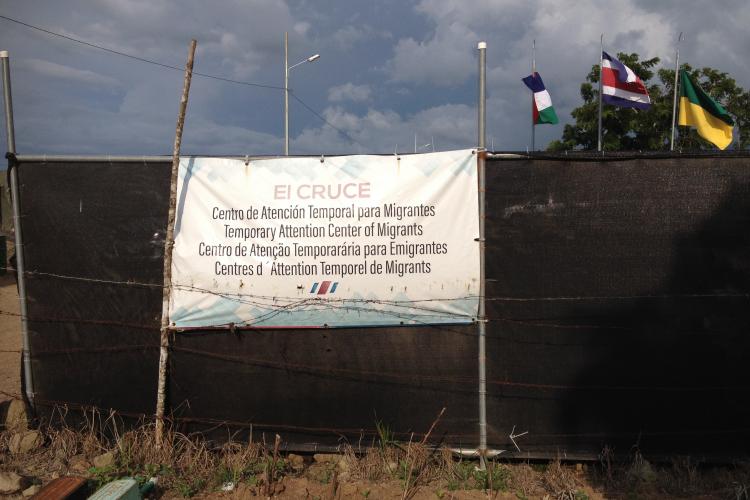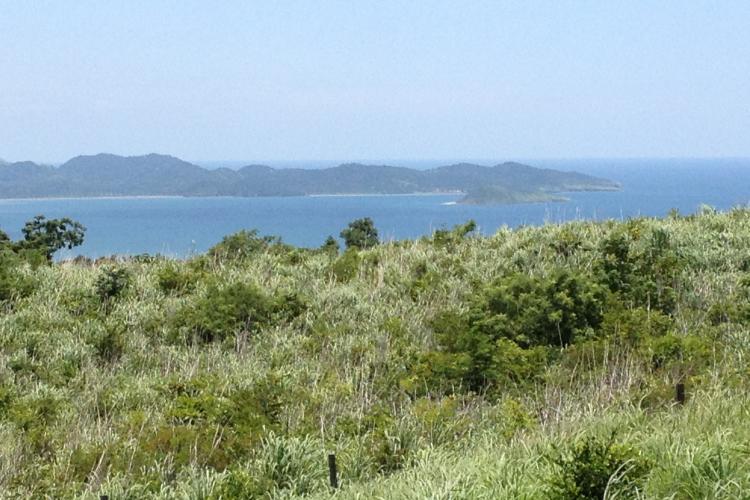Redrawing the Central American Migrant Caravan: How Other (African) Trajectories Cross Its Path
Posted:
Time to read:
Guest post by Nanneke Winters. Nanneke is a researcher at the Department of Anthropology and African Studies (ifeas), Johannes Gutenberg University Mainz (Germany) and affiliated with the University of Antwerp (Belgium). Her research interests include (im)mobility, migrant trajectories and translocal livelihoods in Central America and beyond.
Unexpected intersections
‘I am in Mexico my friend’. In mid-October 2018 I received this message from Micah (a pseudonym), a West-African migrant in his twenties whom I had met a year before while conducting exploratory fieldwork in the northern border region of Costa Rica. As it happens, Micah had decided to continue his long journey from South to North America just as a Central American migrant caravan was heading towards the Mexican border. Calling from Tapachula in southern Mexico, Micah mentioned that at the Mexican border crossing, the migration authorities ‘always allow Africans, but not [migrants from] other continents. They feel pity for the Africans.’ After facing extreme challenges all the way up from Brazil, it was in the Mexican borderlands that he suddenly experienced a relatively advantageous position in what Doreen Massey called the ‘power geometry’ of mobility.
Micah belongs to a group of migrants at the centre of a research project I am carrying out together with Heike Drotbohm. We focus on African migrant trajectories across Central America and argue that these are shaped by different mobilities and immobilities as migrants encounter and engage with embedded local actors, thereby becoming (temporarily) embedded themselves and simultaneously affecting the localities they intersect with. These migrants are often vilified, not in the least in Europe where entry has become so difficult and dangerous that an increasing number of African migrants and refugees tries this route across the Americas instead. Moreover, Micah’s most recent border crossings took place in an often violent and racist context as chronicled by Wendy A. Vogt in her book on Central American migrants in transit through Mexico. Yet Micah describes this latest part of his journey as ‘easy’ and his activities in Tapachula as ‘relaxing’ while waiting for the documents that allow him to travel onwards.
Micah’s story stands in stark contrast to the mediatized stories of Central Americans who joined the most recent migrant caravan and travel under extreme scrutiny. In their attempt to escape from poverty, violence and impunity in the Northern Triangle, their travelling and very being are criminalized and often mobilized for political gain. On the eve of fraught midterm elections, the United States has put enormous pressure on its southern neighbours to deter, disperse and deport these migrants, and has threatened with the reduction of aid as well as with harsher immigration policies and further militarization of the border. Although Central American countries and Mexico have their own political and economic agendas to consider and do not necessarily present a unified, US-style response to the caravan, heightened scrutiny at the region’s borders currently seems inescapable and undoubtedly affects its migration landscape.
Yet, Micah’s story reminds us of the fact that this migrant caravan does not stand on its own. Not only is it part of a ten-year-old tradition of informal migrant organizing that offers relative ‘safety in numbers’ for this dangerous journey, it is also rooted in a region historically defined by migration, and it takes shape along a route of localities crossed by displacements that extend beyond Central America and Central Americans. In our research project, Heike Drotbohm and I attend to these considerations and maintain that no migrant trajectory or constellation of trajectories takes place in a void, in empty space. As the current migrant caravan unfolds, it provides a challenging opportunity to ask how diverse migrant trajectories converge or diverge in different contexts. What kind of disparate developments in regional instability, human movement and local implications do we detect? What other experiences surround this caravan or become effectively invisibilized and perhaps even shielded by it?
Evolving trajectories
Following Micah’s trajectory across the Americas means we should start with Brazil, a country that continues to attract but also to push out African migrants. Micah arrived in São Paolo in 2014, where he stayed for eight months and worked as a cleaner in a restaurant in order to earn money and continue his journey. Because, he said, ‘the expenses [in Brazil] are high so you are left with little money in your hand. So we have to move forward. … From Brazil, a lot of black people were leaving.’ In recent years, Brazil has been plagued by economic instability and political turmoil as well as, in some regions, escalating violence. The country has also been affected by a quickly growing number of Venezuelan refugees, which has led to border instabilities and sometimes clashes with the local population, as evidenced by the recent deployment of military troops to the northern border. Brazilians have just elected Bolsonaro as their president, a far-right former army officer known for his violent language towards specific social groups including Black or Afro-Brazilians and immigrants. It is not hard to imagine that these factors may affect the opportunities for and attitudes towards African migrants in this country and consequently, their desire to move north.
According to Micah, ‘many of them pass. So to us, it’s easy, [the other African migrants] tell you how to move forward. ... It’s not hard to get information, how to move is hard.’ Migrants like Micah travel in conditions that shift between legal and illegal, and that constantly fluctuate between relatively peaceful and extremely dangerous. The different localities that Micah crossed after leaving Brazil (in Peru, Ecuador, Colombia, Panama, Costa Rica and Nicaragua) all have their own, shifting set of immigration discourses, formal regulations and informal practices for dealing with this ‘exotic’, highly visible group of people on the move. But Nicaragua is the only country that blocked the entrance for migrants like Micah completely, in November 2015. Many different factors, including xenophobia, identity politics, domestic security, economic interests, and regional conflicts led to Nicaragua’s decision to put up this ‘muro de contención’ (wall of containment), in effect stranding African migrants just outside its southern border. To complicate matters, since April 2018, Nicaragua has experienced ongoing demonstrations against its authoritarian leadership, violent repression and economic decline, accompanied by an increased sense of insecurity and an extremely polarized population. This crisis has urged thousands of Nicaraguans to flee, mainly to its relatively accessible but increasingly overwhelmed neighbour to the south, Costa Rica.

As these recent developments have further complicated the security of African migrants in the area, many keep trying to move north when the opportunity presents itself. From Costa Rica, they usually try to bypass Nicaragua with a smuggler’s boat or cross its territory walking and hidden away in trucks until they get to Honduras and other Central American countries, which let them pass with temporary visas. Micah dared his second attempt after living and working in the northern border region of Costa Rica for almost two years. He crossed with a small group of other African men and women in a fisherman’s boat, which took eight hours, and then continued by foot to Honduras and by bus to Guatemala and Mexico. Although in earlier conversations he emphasized the dangers of this trip, the risks of deception, drowning, and deportation, during our last phone call he said the two-day trip brought him to Mexico without any major problems. As he put it, at the borders the migration authorities asked him ‘just a little question’. Micah plans to travel onwards to Mexico City and work there for a while, in the meantime contemplating further travel to Canada.

At the same time that migrants like Micah obtain a permit to travel across the country, the Mexican government is offering Central Americans in the caravan access to work, education and health care, on the condition that they ask for asylum in Mexico and remain in its southern states of Chiapas and Oaxaca. In practice, this adds up to an immobilization strategy that fits a more general trend in which Mexico is increasingly considered as a (temporary) destination country for migrants who got stuck along the way or deported from the US. However, for those Central Americans seeking security, Mexico may not quite be far enough. They may cross paths with African and other (extra-continental) migrants again and again in their efforts to move further north.
The Central American migrant caravan is thus surrounded and intersected by other migrant trajectories and other migration landscapes, even extending beyond the Americas. To borrow from Allison Hui, keeping these connections in mind may help us not to ‘exceptionalize’ migrants. In what other ways could the present spotlight on this particular migrant caravan be transformed into more sustained attention for the plight of the highly diverse group of migrants crossing borders today, and of the localities along their route?
Any comments about this post? Get in touch with us! Send us an email, or post a comment here or on Facebook. You can also tweet us.
__________
How to cite this blog post (Harvard style)
Winters, N. (2018) Redrawing the Central American Migrant Caravan: How Other (African) Trajectories Cross Its Path. Available at: https://www.law.ox.ac.uk/research-subject-groups/centre-criminology/centreborder-criminologies/blog/2018/11/redrawing-central (Accessed [date]).
Share:








